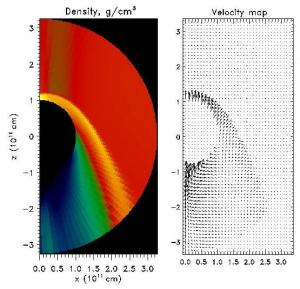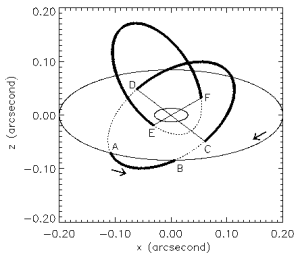 |
|
Figure 1: 2D Hydrodynamical
simulations of a star passing through an
inactive cold disk. The star is modeled as a rigid
sphere centered at x,z = 0,0
with radius of 1011 cm. The left image shows the
gas density, with red representing unshocked disk material, and yellow the
shocked gas. The star is moving along the z-axis in the upward direction,
drilling a narrow hole in the disk. Velocity vectors are shown on the right.
|
|
 |
|
Figure 2: Examples of star's
orbits and the expected flares and eclipses.
The star moving on the ABCD track hits the disk in
points C and D where intense X-ray and weaker near infra-red flares will
be emitted. The coordinates of four such points (e.g. CD and EF) will
define the plane of the disk rotation. Eclipses in points A and B will
constrain the disk size. (From Nayakshin
& Sunyaev 2003).
|
|
|  |
The center of our Galaxy hosts a super massive black hole
that is about 3 million times more massive than our Sun ( Schoedel
et al. 2002; see also T.
Ensslin highlight contribution).
A decade long mystery is why the black hole radiates
only about 0.0001 of the luminosity that is expected from the accretion
of hot gas that is observed to be around it. MPA researchers suggest that
there exists a cold inactive disk around the black hole, a remnant
of past vigorous accretion.
While the disk is too cold (about a 100 K) to be directly
visible, it is much more massive than the hot gas seen in X-rays. According to the new research, when the
hot gas comes into physical contact with the cold disk, the heat is rapidly drained from the hot gas via
thermal conduction. The hot flow effectively gets frozen, and settles
onto the inactive disk at large distances from the black hole. Since the
hot gas is prevented from falling into the black hole's potential well, little
X-ray radiation is emitted (Nayakshin
2003.
The second mystery of our Galactic Center are bursts of
X-ray radiation that happen roughly once per day
and can be more than 100 times brighter than the black
hole quiescent emission. These X-ray flares were discovered two years ago (Baganoff
et al. 2001 ) and are so unique that no reasonable explanation
was givenup to now. However the inactive disk hypothesis
made by the MPA researchers offers a very natural and
easily testable model for the flares. The point is that
there are thousands of stars in the innermost part of our
Galaxy (see
the movie on the MPE infrared group's home page). These
stars rotate with extraordinary high velocities around the super massive
black hole. Generally speaking, these stars will hit the inactive disk
twice per orbit.
While passing through the disk, the stars create a shock
wave which emits X-ray radiation (Fig. 1). The properties of flares expected
from such events are very similar to that actually observed (Nayakshin
& Sunyaev 2003). In addition, the model shows that
similar star-disk encounters yield flares that are too weak to observe in more distant Galactic centers, explaining why these
X-ray flares have been observed only from our
Galactic Center.
The MPA researchers further suggest that observations
of such flares and expected eclipses (see Fig. 2) in the
future will allow us to determine the inactive disk properties
(i.e. mass, size, plane and direction of rotation).
This information should yield crucial clues on the history
of black hole formation in our Galaxy. In addition,
since our Galactic Center is presumed to be similar to
that of many other inactive Galaxies, the discovery of
the inactive disk in our Galaxy could signal a change
in the paradigm of the accretion processes in all the inactive Galaxies.
Sergei Nayakshin
|